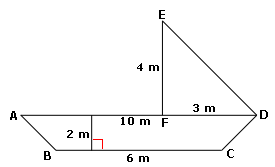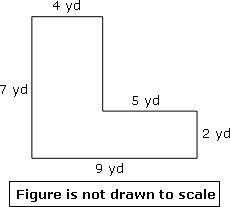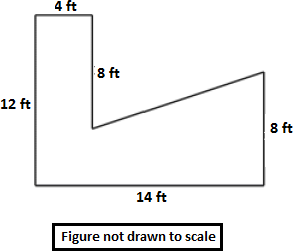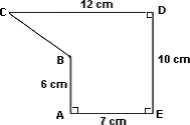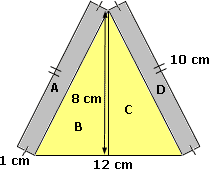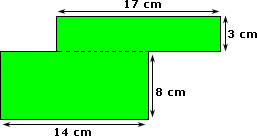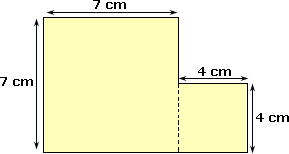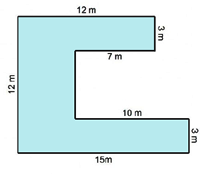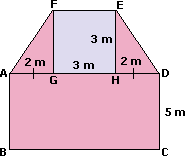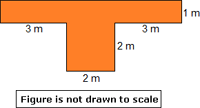Solved Examples and Worksheet for Areas of Composite Plane Figures
Step: 1
The area of the figure = Area of the trapezoid ABCD + Area of the Δ DEF.
Step: 2
The area of the trapezoid ABCD = 1 2
Step: 3
= 1 2
Step: 4
= 1 2
[Substitute AD = 10 m, BC = 6 m and height = 2 m.]
Step: 5
= 1 2
[Simplify.]
Step: 6
= 16 m2
[Simplify.]
Step: 7
The area of ΔDEF= 1 2 1 2
Step: 8
= 1 2
[Substitute FD = 3 m and EF = 4 m.]
Step: 9
= 12 2
[Simplify.]
Step: 10
So, area of the figure = 16 + 6 = 22 m2
[Substitute the values.]
Correct Answer is : 22 m2
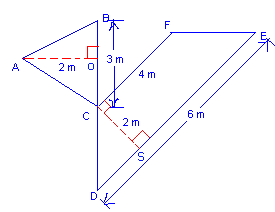
A. 5 m2
B. 12 m2
C. 13 m2
D. None of the above
Step: 1
The total area of the figure = area of the triangle ABC + area of the trapezoid CDEF.
Step: 2
The area of the triangle ABC = 1 2
Step: 3
= (1 2
Step: 4
= (1 2
[Substitute BC = 3 m and AO = 2 m.]
Step: 5
= 3 m 2
[Simplify.]
Step: 6
The area of the trapezoid CDEF = (1 2
Step: 7
= (1 2
Step: 8
= (1 2
[Substitute CS = 2, CF = 4 and DE = 6.]
Step: 9
= (1 2
[Work inside the grouping symbols.]
Step: 10
= 10 m2
[Simplify.]
Step: 11
The total area of the figure = 3 + 10 = 13 m2.
[Substitute the values.]
Correct Answer is : 13 m2
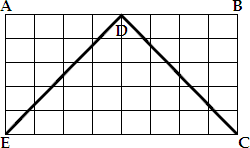
A. 40 cm2
B. 60 cm2
C. 20 cm2
D. 80 cm2
Step: 1
In the given figure, the area of ABCE is 40 cm2 and the area of ECD is 20 cm2.
[Given.]
Step: 2
The area of ABCDE = area of ABCE - area of ECD
[From the given figure.]
Step: 3
= 40 - 20
[From step 1.]
Step: 4
= 20
[Subtract.]
Step: 5
Therefore, the area of the given figure ABCDE is 20 cm2 .
Correct Answer is : 20 cm2
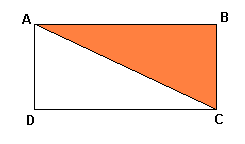
A. 24 cm.2
B. 28 cm.2
C. 12 cm.2
D. 16 cm.2
Step: 1
Diagonal AC divides the rectangle into two congruent triangles.
Step: 2
Area of the triangle ABC = 12 cm2.
Step: 3
Area of the rectangle ABCD = 2 × area of traingle ABC.
= 2 × 12
Step: 4
So, the area of the rectangle ABCD = 24 cm2.
Correct Answer is : 24 cm.2
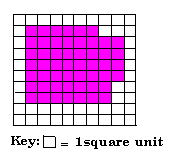
A. 56 square units
B. 48 square units
C. 44 square units
D. 52 square units
Step: 1
In the given figure, 52 squares are colored.
Step: 2
Area of each square = 1 square unit.
Step: 3
Area of 52 squares = 52 × 1 = 52 square units.
Correct Answer is : 52 square units
Step: 1
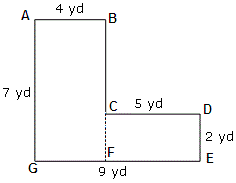
Step: 2
From the figure, Area of the rectangle ABFG = length × width = AG × AB = 7 × 4 = 28 sq.yd
Step: 3
Area of the rectangle CDEF = length × width = CD × DE = 5 × 2 = 10 sq.yd
Step: 4
Total area of the figure ABCDEFG = area of the rectangle ABFG + area of the rectangle CDEF
Step: 5
= 28 + 10 = 38
Step: 6
So, total area = 38 sq.yd
Correct Answer is : 38 yd2
Step: 1
Label the given figure as shown below and draw line EH perpendicular to DF.
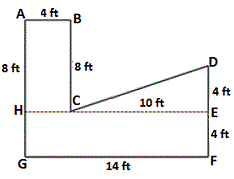

Step: 2
Area of rectangle ABCH = 8 × 4 = 32 sq ft.
[Area of rectangle = length × width.]
Step: 3
Area of triangle CDE = 1 2
[Area of triangle = 1 2
Step: 4
Area of rectangle EFGH = 14 × 4 = 56 sq ft.
[Area of rectangle = length × width.]
Step: 5
The total area of the given figure ABCDEFGH = Area of rectangle ABCH + Area of triangle CDE + Area of rectangle EFGH.
Step: 6
= 32 + 20 + 56
[From steps 2, 3, and 4.]
Step: 7
= 108
[Add.]
Step: 8
Therefore, the total area of the given figure is 108 sq ft.
Correct Answer is : 108 sq ft
Step: 1
[Draw BF ¯ ⊥ ED ¯
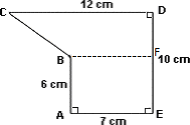
Step: 2
ABFE is a rectangle in which AB = EF = 6 cm and AE = BF = 7 cm. BCDF is a trapezium in which CD = 12 cm, BF = 7 cm and DF = 4 cm as shown.
Step: 3
Area of rectangle ABFE = 7 × 6 = 42 cm2
[Area of a rectangle = length × width.]
Step: 4
Area of trapezoid = ( 1 2
[Area of trapezoid = 1 2 h b b
Step: 5
Total area of the figure = 42 + 38 = 80 cm2
Correct Answer is : 80 cm2
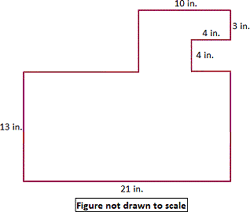
A. 363 sq in
B. 399 sq in.
C. 360 sq in
D. 327 sq in.
Step: 1
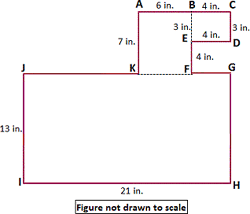
Step: 2
The given figure is divided into 3 rectangles.
Step: 3
Area of rectangle = length × width.
Step: 4
Area of rectangle ABFK = 7 × 6 = 42 sq in.
Step: 5
Area of rectangle BCDE = 4 × 3 = 12 sq in.
Step: 6
Area of rectangle GHIJ = 21 × 13 = 273 sq in.
Step: 7
Total area of the given figure ABCDEHGHIJK = Area of rectangle ABFK + Area of rectangle BCDE + Area of rectangle GHIJ.
Step: 8
= 42 + 12 + 273
[From steps 4, 5, and 6.]
Step: 9
= 327
[Add.]
Step: 10
Therefore, the total area of the given figure is 327 sq in.
Correct Answer is : 327 sq in.
Step: 1
Area of the figure = Area of A + Area of B + Area of C + Area of D
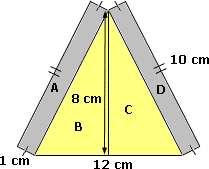

Step: 2
Area of A = Area of D
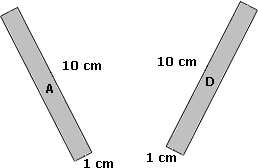
[The dimensions of A and D are the same.]

Step: 3
Area of A = Area of D = 1 cm × 10 cm = 10 cm2
[Area of a rectangle = length × width.]
Step: 4
Area of B = Area of C
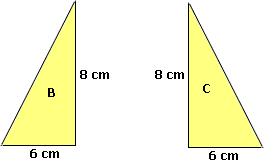
[The dimensions of B and C are the same.]

Step: 5
Area of B = Area of C = 1 2
[Area of a triangle = 1 2
Step: 6
Area of the figure = 10 cm2 + 24 cm2 + 24 cm2 + 10 cm2
[Substitute the values.]
Step: 7
= 68 cm2
[Add.]
Step: 8
Therefore, area of the figure is 68 cm2.
Correct Answer is : 68 cm2
Step: 1
The area of a composite 2-D shape can be found by finding the areas of individual shape and adding them up.
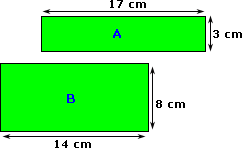

Step: 2
Area = Length × Width
Step: 3
Area A = 17 × 3 = 51 cm2
Step: 4
Area B = 14 × 8 = 112 cm2
Step: 5
Total area = 51 cm2 + 112 cm2 = 163 cm2
Step: 6
So, the area of the given composite shape is 163 cm2.
Correct Answer is : 163 cm2
Step: 1
The area of a composite 2-D shape can be found by finding the areas of individual shape and adding them up.
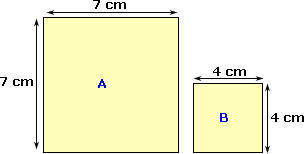

Step: 2
Area = Length × Width
Step: 3
Area A = 7 × 7 = 49 cm2
Step: 4
Area B = 4 × 4 = 16 cm2
Step: 5
Total area = 49 cm2 + 16 cm2 = 65 cm2
Step: 6
So, the area of the given composite shape is 65 cm2.
Correct Answer is : 65 cm2
Step: 1
The figure is divided into three rectangles.
Step: 2
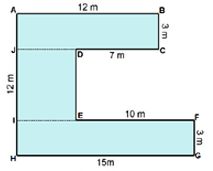
Step: 3
Area of the figure = Area of rectangle ABCJ + Area of rectangle DEIJ + Area of rectangle FGHI
Step: 4
= AB × BC + JD × DE + IF × FG
Step: 5
= 12 × 3 + 5 × 6 + 15 × 3
Step: 6
= 36 + 30 + 45 = 111
Step: 7
Therefore, area of the figure is 111 m2.
Correct Answer is : 111 m2
Step: 1
Area of the figure = Area of trapezium FADE + Area of rectangle ABCD
Step: 2
= 1 2
Step: 3
= 1 2
Step: 4
= 15 + 35 = 50
Step: 5
Therefore, area of the figure is 50 m2.
Correct Answer is : 50 m2
Step: 1
The figure is divided into a square and a rectangle.
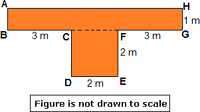

Step: 2
Area of the figure = Area of square CDEF + Area of rectangle ABGH
Step: 3
= DE × EF + AH × GH
[Area of rectangle = length × width, and Area of square = side × side.]
Step: 4
= 2 × 2 + 8 × 1 = 4 + 8 = 12
Step: 5
Therefore, area of the figure is 12 m2.
Correct Answer is : 12 m2
- Areas of Triangles-Gr 6-Solved Examples
- Net Figures made up of Rectangles and Triangles-Gr 6-Solved Examples
Related Worksheet
- Division
